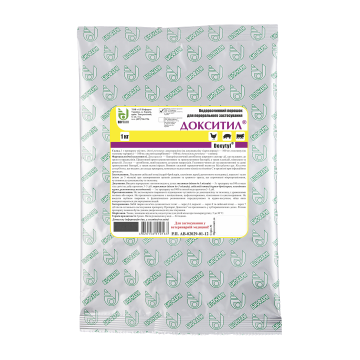DOXYTIL®
water-soluble powder for oral administration
Description
Water-soluble light-yellow powder.
Composition
1 g of the drug contains:
active ingredients: doxycycline (in form of doxycycline hydrochloride) – 100 mg; tylosin (in form of tylosin tartrate) – 100 mg; ascorbic acid – 100 mg;
excipient: glucose.
water-soluble powder for oral administration
Description
Water-soluble light-yellow powder.
Composition
1 g of the drug contains:
active ingredients: doxycycline (in form of doxycycline hydrochloride) – 100 mg; tylosin (in form of tylosin tartrate) – 100 mg; ascorbic acid – 100 mg;
excipient: glucose.
Pharmacological properties
ATC vet QJ01 - antibacterials for systemic use. QJ01RA90 - tetracyclines, combinations with other antibacterials.
Doxycycline is a broad-spectrum bactericidal antibiotic of the tetracycline group. It is effective against gram-positive and gram-negative bacteria (Staphylococcus spp., Streptococcus spp., Bac. аnthracis, Clostridium spp., Listeria spp., Actinomyces spp., Klebsiella spp., Shigella spp., Yersinia spp., Bordetella spp., Campylobacter spp., E. coli, Haemophilus spp., Pasteurella spp., Salmonella spp.), chlamydiae (Chlamydia spp.), mycoplasma (Mycoplasma spp.) and rickettsiae (Rickettsia spp.). Its mechanism of action consists in inhibition of synthesis of microbial cell proteins through binding of receptors of ribosomal 30S subunit of microorganisms. Doxycycline blocks attachment of aminoacyl tRNA to acceptor site, preventing attachment of new amino acids to peptide chain and preventing in such way synthesis of microbial proteins.
Tylosin is an antibiotic of the macrolide group. It mostly acts upon gram-positive and certain gram-negative bacteria (Campylobacter spp., Pasteurella spp., Staphylococcus spp., Streptococcus spp., Treponema spp.), as well as large viruses. It demonstrates strong therapeutic effect upon Mycoplasma spp. The mechanism of action consists in binding with ribosomal 50S subunit of microbial cell, preventing translocation of peptides and thus inhibiting synthesis of proteins.
Ascorbic acid, which is one of drug ingredients, makes up the vitamin С deficiency in the body during infection processes.
Doxycycline penetrates into lungs, thus, it is effective in treatment of respiratory infections. After oral administration, doxycycline is well absorbed from the digestive tract and reaches its maximum serum concentration in 2 hours. If there is any feed in digestive tract, it does not significantly affect the drug absorption. Bioavailability of doxycycline after oral administration makes 50-80%. Doxycycline is well dissolved in lipids and distributes in most tissues. Doxycycline is not considerably biotransformed before excretion. Half-life in calves makes 9.8 hours, in cows – 14.2 hours, in chickens – 4.8 hours, in swine – 3.9 hours. Doxycycline, unlike other tetracyclines, is released into intestinal tract in large amount and inactivated. Out of 90 % of the substance 16 % is excreted in urine, about 5 % - in bile, the rest is excreted intestinally.
Maximum tylosin concentration in blood serum after oral administration is reached in 2 hours. Due to its high lipid solubility, tylosin is widely distributed in the body and drug concentrations in tissues may significantly exceed concentrations in blood serum for 2-36 hours after drug administration. Tylosin is primarily exccreted in bile (68%) and urine (24%), partially – in feces.
Ascorbic acid is well absorbed after oral administration, nevertheless, its amount decreases proportionally according to the dose. Ascorbic acid is widely distributed in body tissues. Its maximum concentrations may be present in liver, leukocytes, blood platelets and endocrine glands. About 25% of ascorbic acid binds to proteins in plasma. It crosses the placental barrier well and is found in milk. Its half-life in plasma makes 16 days, but in case of excessive amount, it may be reduced to several hours. Renal threshold makes about 14 μg/ml for ascorbic acid, but this level may be different individually. If threshold concentrations of vitamin C in blood are exceeded, ascorbic acid is excreted unchanged renally. On the contrary, in case of deficiency there is no excretion in urine. Non-reactive metabolites (ascorbic acid-2-sulfate and oxalic acid) are excreted in urine.
Administration
Treatment of poultry (broiler chickens, breeding hens, pullets), piglets and calves (of up to 3 months of age) against diseases of respiratory organs and digestive tract caused by doxycycline- and tylosin-sensitive microorganisms
Dosage
Administer orally with drinking water in the following doses:
- calves (under 3 months old) - 5 g per 100 kg body weight twice a day for 3-5 days;
- piglets (under 3 months old), poultry (broiler chickens, breeding hens, pullets) - 1 kg per 1 t of drinking water for 3-5 days.
Contraindications
Do not administer to animals with hypersensitivity to doxycycline and tylosin, with liver and kidney disorders. Do not administer in combination with penicillins, cephalosporins, quinolones and cycloserines. Do not administer to ruminants with functionally developed proventriculi and hens, laying eggs for human consumption.
Precautions
Animal slaughter for meat is allowed as follows: calves – in 14, piglets – in 8 and poultry – in 7 days following the last administration. Meat, obtained before the mentioned term shall be utilized or fed to non-productive animals depending on the statement of a veterinary physician.
Doxytil® is not prescribed in sub-therapeutic doses. Possible allergic reactions. Doxycycline, as the drug component may cause structural changes in liver and kidneys, diarrhea.
Medicated solution shall be the only source of drinking water throughout the whole treatment period.
Packaging
Packages made of film or foil materials of 1000 g.
Storage
Store in a dry, dark, damp-proof place out of reach of children at 5-30°С.
Shelf life
2 years.
24 hours after dilution in water.
For veterinary use only!
